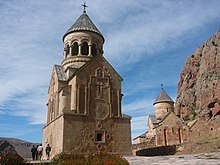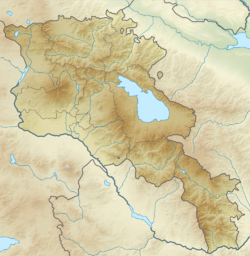
Back Noravank AVK Klášter Noravank Czech Norawank German Νοραβάνκ Greek Monaĥejo Noravank Esperanto Noravank Spanish نوراوانک Persian Noravank French Noravank Frisian Noravank Croatian
This article needs additional citations for verification. (November 2024) |
| Noravank | |
|---|---|
Նորավանք | |
 Surb Astvatsatsin and Surb Karapet Churches with Surb Grigor's Chapel to the right, Noravank | |
| Religion | |
| Affiliation | Armenian Apostolic Church |
| Location | |
| Location | Amaghu Valley, Vayots Dzor Province, Armenia |
| Geographic coordinates | 39°41′03″N 45°13′58″E / 39.684061°N 45.232872°E |
| Architecture | |
| Style | Armenian |
| Groundbreaking | 1205 |
Noravank (Armenian: Նորավանք, lit. 'new monastery') is a 13th-century Armenian monastery, located 122 km from Yerevan in a narrow gorge made by the Amaghu River, near the town of Yeghegnadzor in Armenia. The gorge is known for its tall, sheer, brick-red cliffs, directly across from the monastery. The monastery is best known for its two-storey Surb Astvatsatsin (Holy Mother of God) Church, which grants access to the second floor by way of a narrow stone-made staircase jutting out from the face of building.
The monastery is sometimes called Noravank at Amaghu, with Amaghu being the name of a small and nowadays abandoned village above the canyon, in order to distinguish it from Bgheno-Noravank, near Goris. In the 13th–14th centuries the monastery became a residence of Syunik's bishops and, consequently, a major religious and, later, cultural center of Armenia closely connected with many of the local seats of learning, especially with Gladzor's famed university and library.

